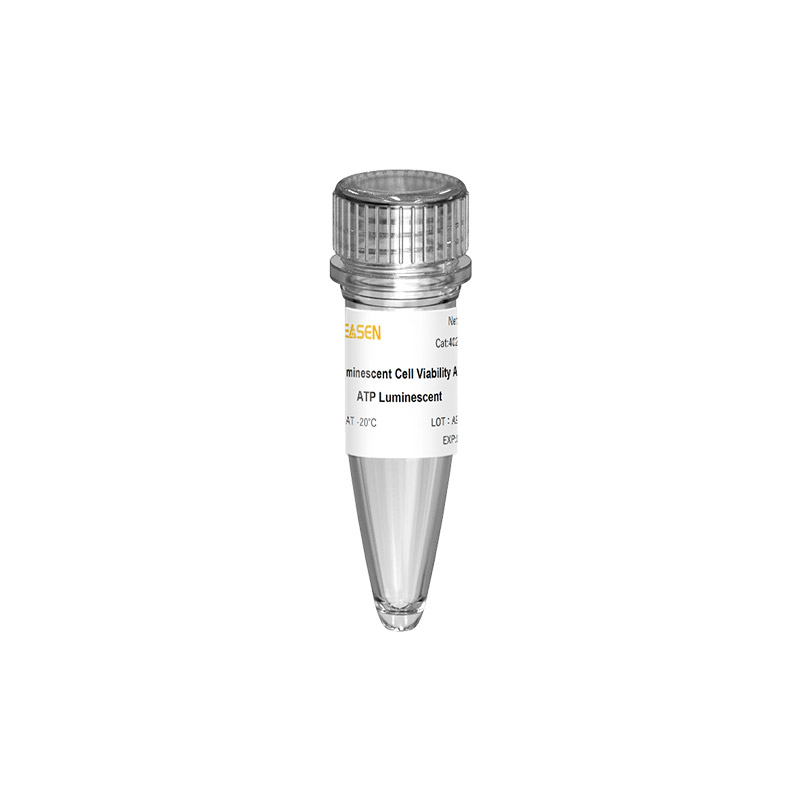ATP Luminescent Cell Viability Assay Kit
Product Description
ATP Luminescent cell viability assay kit provided by Yeasen has a wide linear range, high sensitivity, and good stability. In the 96-well plates, there was a good linear relationship between 100 and 100,000 cells, but the upper limit for the number of cells was different. In addition, the operation is simple, the detection reagent provided in the kit is stable reading, fast detection, only about 10 minutes to complete the detection, there is no need to wash cells, and there is no need to replace or remove the culture medium. Compared with other common cell viability determination methods, such as Calcein-AM, CCK-8, etc., cell viability detection by the luminescence method is simpler and faster.
Shipping and Storage
The components are shipped with an ice pack and can be stored at -20°C for 1 year.
Cautions
1. The reagent contains luciferase, and repeated freezing and thawing will affect its activity. It is recommended to store at -20°C away from light.
2. Reagents and cell samples should be balanced to room temperature before use to avoid the influence of enzyme catalytic effect.
3. High drug content may interfere with luciferase reaction, thus affecting chemiluminescence signal.
4. For research use only!
Instructions
1. Cell culture
A 96-well plate suitable for chemiluminescence detection was used, and 100 μL cells were inoculated in each well (the initial inoculated cell density was determined according to the culture time, and the number of cells in each well should not exceed 100,000). Meanwhile, the wells without cells were set as a negative control. Cells were cultured at 37℃ with 5% CO2. Cell concentration gradients can also be set to obtain optimal experimental results. Treat the cells at appropriate times as needed.
2. (Optional) ATP standard curve production
Dilute the prepared ATP standard solution to an appropriate concentration gradient with PBS, and add 100 μL standard solution to each well of 96-well plate.
3. Cell viability detection
1. Melt and thaw the existing luminescence detection reagent, and balance it to room temperature;
2. Take out the cell culture plate and balance it at room temperature for 10 mins;
3. Add 100 μL detection reagent to each well of the 96-well plate (due to the edge effect of the well, it may lead to an unstable luminous signal, so it is not recommended to lay the plate at the edge);
4. Oscillate at room temperature for 2 mins to promote cell lysis;
5. Place at room temperature for 10 mins to stabilize the luminescent signal;
6. Chemiluminescence detection was carried out with a multi-functional enzyme reader. Set the corresponding parameters according to the requirements of the instrument, the detection time of each hole is generally 0.25-1 s, and the specific need to be adjusted according to the sensitivity of the instrument;
7. Calculate the relative activity of cells according to the chemiluminescence reading, or calculate the ATP content according to the ATP standard curve to obtain the relative activity of cells.
[Notes]: The detection effect varies with the type of cells. For some cells with particularly high ATP content, chemiluminescence readings may continue to rise but lose linear relationship when the number of cells reaches 100,000 or more.
[1] Zou Y, Chen X, Sun Y, et al. Antibiotics-free nanoparticles eradicate Helicobacter pylori biofilms and intracellular bacteria [published online ahead of print, 2022 Jun 9]. J Control Release. 2022;348:370-385. doi:10.1016/j.jconrel.2022.05.044(IF:9.776)
[2] Mao G, Xin D, Wang Q, Lai D. Sodium molybdate inhibits the growth of ovarian cancer cells via inducing both ferroptosis and apoptosis. Free Radic Biol Med. 2022;182:79-92. doi:10.1016/j.freeradbiomed.2022.02.023(IF:7.376)
Catalog No.:*
Name*
phone Number:*
Lot:*
Email*
Country:*
Company/Institute:*
Recommended products

